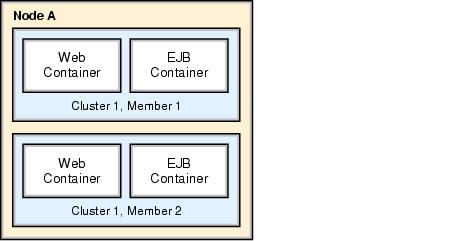Scalability
Clustering is an effective way to perform vertical and horizontal scaling of appservers.
In vertical scaling, shown in Figure 1-6, multiple cluster members for an appserver are defined on the same physical machine, or node, which may allow the machine's processing power to be more efficiently allocated.
Even if a single JVM can fully utilize the processing power of the machine, you may still want to have more than one cluster member on the machine for other reasons, such as using vertical clustering for software failover. If a JVM reaches a table/memory limit (or if there is some similar problem), you can have another process to go to for failover.
Figure 1-6 Vertical scaling
We recommend that you avoid using "rules of thumb" when determining the number of cluster members needed for a given machine. The only way to determine what is correct for your environment and application(s) is to tune a single instance of an appserver for throughput and performance, then add it to a cluster, and incrementally add additional cluster members. Test performance and throughput as each member is added to the cluster. Always monitor memory usage when you are configuring a vertical scaling topology and do not exceed the available physical memory on a machine.
In general, 85% (or more) utilization of the CPU on a large server shows that there is little, if any, performance benefit to be realized from adding additional cluster members.
Figure 1-7 Horizontal scaling
Horizontal scaling can handle appserver process failure and hardware failure without significant interruption to client service.
WebSphere applications can combine horizontal and vertical scaling to reap the benefits of both scaling techniques, as shown in Figure 1-8.
Figure 1-8 Vertical and horizontal scaling
WebSphere is a trademark of the IBM Corporation in the United States, other countries, or both.
IBM is a trademark of the IBM Corporation in the United States, other countries, or both.


